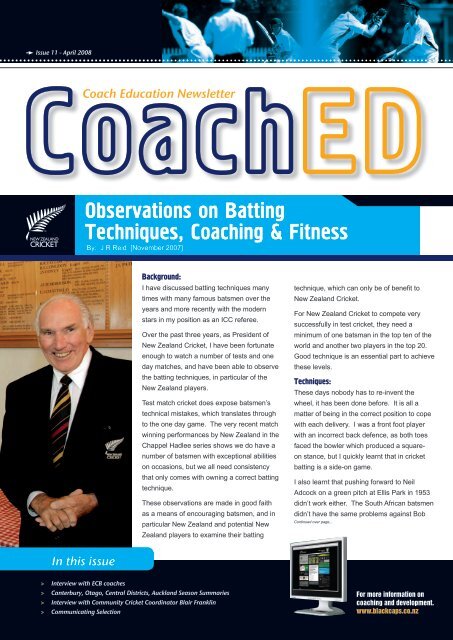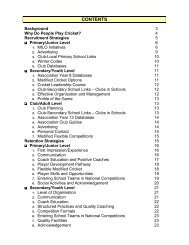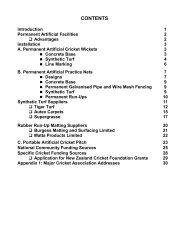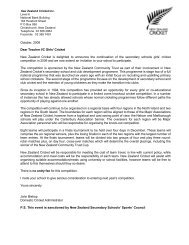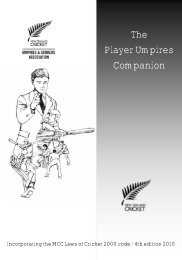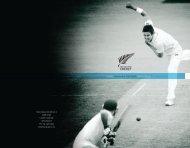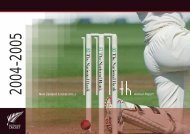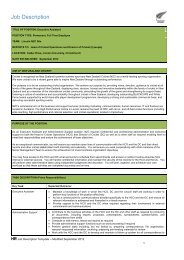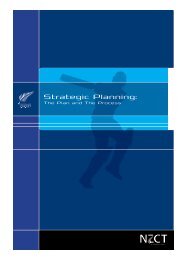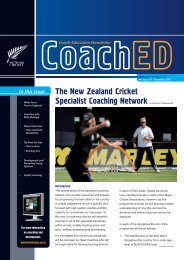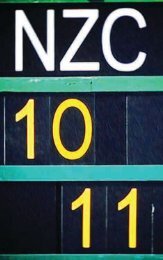Observations on Batting Techniques, Coaching & Fitness
Observations on Batting Techniques, Coaching & Fitness
Observations on Batting Techniques, Coaching & Fitness
Create successful ePaper yourself
Turn your PDF publications into a flip-book with our unique Google optimized e-Paper software.
Interview with ECB Coaches- Rupert Kitzinger and Alastair Maiden By Chris Fergus<strong>on</strong>What are you doing here in NZ?So what differences have you seen so far,between what’s happening in the UK, andRupert: We are <strong>on</strong> ECB <strong>Coaching</strong>what is happening here?Scholarships funded by the Lord’s Tavernerswho are the biggest charity for recreati<strong>on</strong>al Rupert: The main difference with coachcricket in England and Wales. To be selected educati<strong>on</strong> is that here you’ve got what wewe had to be an ECB level 3 coach andthink is a very good well structured pathwaythen go through anfor coaches that mirrorapplicati<strong>on</strong> process.your player pathway.There were fourBack home in England wescholarships in all, twohave various developmentwere sent to Australiacourses for teachers andand two here to Newyoung leaders. We’veZealand. We havegot a Level 1 which isbeen asked to researchlike a <strong>Coaching</strong> Assistantvarious areas of Newqualificati<strong>on</strong>, a Level 2Zealand Cricket andwhich is a Coach, so theyshare ideas with peopleshould be able to run awe speak to, finding outstructured sessi<strong>on</strong>, andwhat they’re doing andLevel 3 is a Head Coachthey can find out whatpositi<strong>on</strong> qualificati<strong>on</strong>.Rupert and Alastairwe are doing in the UK.This is not aligned withReally in effect I guess it’s like an official spy how players develop, you could get a Levelmissi<strong>on</strong> with the overall aim of sharing and 1 Coach working with a group of U17s forpromoting cricket between the two countries. example, you could also get a Level 3 Coachworking in primary schools which is obviouslya good thing, but it’s <strong>on</strong>e of the mainWhat is the purpose of the visit here?differences between the coach educati<strong>on</strong>Alastair: We’ve been asked to look into what programmes.New Zealand Cricket is doing in terms ofAlastair: We’ve also got a Level 4 course <strong>on</strong>their coach educati<strong>on</strong> structure. There wastop of that, which is a very elite qualificati<strong>on</strong>a previous scholarship over here about fivefor people working in the professi<strong>on</strong>al game.years ago, Phil Relf came over and lookedat what was going <strong>on</strong> so we want to know Rupert: In light of the research that Phil Relfhow things have changed, what people are did five years ago, we transformed our coachdoing now. We are interested in looking at educati<strong>on</strong> system to be more focused <strong>on</strong> thefast bowling developments and what New ‘how to coach’ rather than the technical ‘whatZealand Cricket is doing with fast bowlers; we need to coach’, and that has been a bigtalent identificati<strong>on</strong>, so how you identify your difference for us over the last few years intalent; LTAD (l<strong>on</strong>g term athlete development) England. So far in New Zealand we’ve <strong>on</strong>ly– what the thought process is for that and how got out to see <strong>on</strong>e evening of coach educati<strong>on</strong>that’s integrated into the system; women’s where the c<strong>on</strong>tent was very good but wasand girl’s cricket, and what’s happening there; slightly more ‘what to’, than ‘how to’.and disability cricket.Alastair: The other big difference for us hasRupert: We are also looking at the coaching been an outside organisati<strong>on</strong> taking over thestyles that coaches use over here, andprinciples of the coach educati<strong>on</strong> structureascertain the differences between Newin England. We’ve got a UKCC, (UnitedZealand and England.Kingdom <strong>Coaching</strong> Certificate), which is aThe maindifferencewith coacheducati<strong>on</strong>is that hereyou’ve gotwhat we thinkis a very goodwell structuredpathway
Canterbury - Seas<strong>on</strong> SummaryCanterbury age group teams achieved muchsuccess over the past seas<strong>on</strong>. Apart fromthe U19s, all teams w<strong>on</strong> their respectivetournaments.The team results are listed below. Whilst theresults of our age group representative teamsare not as important as the development ofour cricketers, it is nevertheless a reflecti<strong>on</strong> ofthe impact that the development programmeshave had <strong>on</strong> our young players.Wiseman, McCullum, Martin, Cunis, Stead)which has provided opportunities for formerage group players to make the step up tofirst class cricket. It is encouraging and acredit to the players and the coach, DaveNosworthy, that the team has performed sowell. Dave has created a very tight unit thathas worked extremely hard <strong>on</strong> fitness and skilldevelopment and fully deserve the successthey have enjoyed.I would emphasise that our ultimate goal is toprovide the finest opportunities and the bestenvir<strong>on</strong>ment for our young athletes to developtheir skills. We must c<strong>on</strong>tinue to challengeour coaches and evaluate our developmentsystems to provide the ultimate learningexperience so that both coaches and athletescan both enjoy their cricket and reach theirpotential.Results of Canterbury age group teams forthe 2007-8 seas<strong>on</strong>:Canterbury ‘A’The Canterbury ‘A’ team were competitive butfailed to win any games. A large number ofplayers were used (24) which, whilst givingthem exposure at this level, was not idealfor team cohesi<strong>on</strong> and c<strong>on</strong>tinuity. All theirgames were played <strong>on</strong> the excellent batsmanfriendlyMainpower Oval in Rangiora. DarrenBroom and Michael Davids<strong>on</strong> were the mostsuccessful batsman and bowler respectivelyand were rewarded by selecti<strong>on</strong> for theTeam Tournament Positi<strong>on</strong> CoachU19 Nati<strong>on</strong>al 1st = 2 day Mike Johnst<strong>on</strong>6th 1 day6th overallU17 Nati<strong>on</strong>al 1st 2 day Neil Fletcher1st 1 day1st overallI wouldemphasisethat ourultimate goalis to providethe finestopportunitiesand the bestenvir<strong>on</strong>mentfor our youngathletes todevelop theirskills.Canterbury Black Z<strong>on</strong>al U15 1st Glenn HooperCanterbury Red Z<strong>on</strong>al U15 2nd Stephen CunisWomen’s Devt Nati<strong>on</strong>al 1st Mandie GodlimanU17 Girls Z<strong>on</strong>al U17 1st Nigel MarshCanterbury WizardsThe Wizards have generally ‘punchedabove their weight’ this seas<strong>on</strong> being verycompetitive in all competiti<strong>on</strong>s reaching thesemi-final of the State Shield, missing out<strong>on</strong> the State Twenty20 final <strong>on</strong> run rate andat the time of going to press having just w<strong>on</strong>the State Champi<strong>on</strong>ship. Canterbury haslost many experienced players in the lastcouple of years (Cairns, Astle, McMillan,Wizards later in the seas<strong>on</strong>. The team hadworked very hard over winter and remainedvery positive despite some disappointingresults.This c<strong>on</strong>tinues to be a very valuabletournament that provides opportunity forpotential first class players to competeagainst quality oppositi<strong>on</strong> in first classc<strong>on</strong>diti<strong>on</strong>s.
Canterbury U19Expectati<strong>on</strong>s were high for the young U19team but they were not able to defend theirtitle they w<strong>on</strong> in the 2006-7 seas<strong>on</strong>. Theyw<strong>on</strong> their first game outright, a three dayeragainst Otago, but the team then moved outto Lincoln for the rest of the tournament and,very disappointingly and surprisingly, did notwin another game, finishing 6th. The overallperformance was reflected in <strong>on</strong>ly <strong>on</strong>e player,Corey Anders<strong>on</strong>, being selected in the NewZealand team to play in the U19 World Cup.Several players had been in c<strong>on</strong>siderati<strong>on</strong>prior to the tournament but simply underperformed at the tournament.The team was young, with 7 of the 14players used available at U19 level againnext seas<strong>on</strong>. One significant factor in theteam’s performance was that <strong>on</strong>ly two playershad played in last year’s tournament forCanterbury. Experience at this tournamenthas proved crucial in the past with playersgenerally performing much better in theirsec<strong>on</strong>d year.Canterbury U17The U17s w<strong>on</strong> the nati<strong>on</strong>al title with a fineall round team performance. Three playerswere selected in the nati<strong>on</strong>al U17 team: TomLatham, Matt McEwan and Tim Johnst<strong>on</strong>.Latham and McEwan w<strong>on</strong> the ‘Best Batsman’and ‘Best Bowler’ of the tournament awardsrespectively. Tim Johnst<strong>on</strong> was the leadingtournament wicket taker. The team’s successwas built around a ‘never-say-die’ attitude,c<strong>on</strong>tributi<strong>on</strong>s from all batsmen at crucial timesand steady bowling performances.Canterbury U15Two Canterbury U15 teams played theircounterparts in a z<strong>on</strong>al tournament againstOtago and both teams w<strong>on</strong> c<strong>on</strong>vincingly.At school level Christchurch Boys’ HighSchool w<strong>on</strong> the Gillette Cup for the third yearin a row reaffirming them to be the leadingsec<strong>on</strong>dary school in New Zealand.Canterbury MagiciansCanterbury women’s cricket has enjoyedunprecedented success this seas<strong>on</strong>, winningall three nati<strong>on</strong>al tournaments. The Magiciansw<strong>on</strong> the inaugural State League Twenty20trophy, a competiti<strong>on</strong> that was thoroughlyenjoyed by all the players and a welcomeadditi<strong>on</strong> to the women’s game. They alsoretained the State League title winning thefinal by 7 wickets. This proved to be a highlysuccessful first seas<strong>on</strong> for Gary Stead ascoach. Several new players were introducedto first class cricket and c<strong>on</strong>tributed well whichbodes well for the future.Canterbury Women’s DevelopmentThe Canterbury Women’s Developmentteam w<strong>on</strong> their nati<strong>on</strong>al tournament for thethird time in four years. This was a veryyoung team that played excepti<strong>on</strong>ally well allweek. They beat Auckland in the final havingbeen soundly beaten by them in the roundrobin game.Three players (Frances Mackay, JanetBrehaut and Lizzie Rae) went <strong>on</strong> to maketheir debuts for the Magicians as a result oftheir performances at this tournament.This team was specifically selected witha view to the future, a young team whothe selectors felt could all progress to firstclass cricket within the next 5 years. Thisis particularly relevant as it is expected thatseveral Magicians will retire from first classcricket after the next World Cup in Australiain 2009.Canterbury Sec<strong>on</strong>dary SchoolgirlsThe sec<strong>on</strong>dary schoolgirls’ team played twogames against their Otago counterparts andwere c<strong>on</strong>vincing winners.The future of women’s cricket in Canterburylooks str<strong>on</strong>g.SummaryOne of the most encouraging statistic to comeout of the seas<strong>on</strong> is that of the 21 playerswho have played for the Canterbury Wizardsthis seas<strong>on</strong>, 17 have come through our agegroup and high performance programmes.There are some areas of c<strong>on</strong>cern: qualitywicket keepers, top order batsmen andseam bowlers with genuine pace are all inshort supply. I’m sure that Canterbury is notthe <strong>on</strong>ly major associati<strong>on</strong> struggling to findtalented players in these areas. This problem
should be somewhat alleviated by theintroducti<strong>on</strong> of the specialist skill coachesin all skill areas. On a positive note, thereare several spinners with real promisecoming up through the age group ranks inCanterbury.Richard HaywardMarch 2008
Otago Cricket - Seas<strong>on</strong> RoundupOtago’s win in the State Shield capped amemorable cricket seas<strong>on</strong> down south. Thevictorious <strong>on</strong>e day side was met by a largecrowd at Dunedin Airport, and then treated toa Mayoral recepti<strong>on</strong>, hammering home to theplayers just how significant this result was fora province starved of major cricket trophiesfor more than 20 years.Particularly satisfying for the locals was thefact that most of the players learned the gamein Otago. Brend<strong>on</strong> McCullum’s heroics inthe final came as no surprise to those whohad watched him and his brother Nathansmashing tennis balls round Carisbrook asyoungsters when their father Stu was playingfor Otago in the 1980s. Brend<strong>on</strong>’s brilliant170 tended to overshadow the efforts of histeam mates but make no mistake – Otago’ssuccess was built <strong>on</strong> solid teamwork and a lotof hard work over the past few seas<strong>on</strong>s underthe guidance of coach Mike Hess<strong>on</strong>.The work ethic established has seen playersblossom and the rewards are coming. BradleyScott, Nathan McCullum, Neil Broom, WarrenMcSkimming, Aar<strong>on</strong> Redm<strong>on</strong>d and JamesMcMillan were selected for New Zealand‘A’, with Mike Hess<strong>on</strong> as assistant coach,while McCullum, Craig Cumming, Scott andBrend<strong>on</strong> McCullum made the BLACKCAPS.The seas<strong>on</strong> also saw the return of test cricketto Otago, and the picturesque UniversityOval became test venue number 96 in theworld, justifying the bold and forward thinkingdecisi<strong>on</strong> to shift Otago Cricket’s headquarter’sfrom Carisbrook to the new ground threeseas<strong>on</strong>s ago.Not surprisingly there has been a real buzzaround Otago Cricket over the past year ortwo. The challenge for Otago Cricket is toboth foster and capitalise <strong>on</strong> the heightenedinterest.Already there has been an increase inthe numbers throughout the provinceplaying twilight or social cricket, a reminderof the need to cater for all levels of interestand ability.There can be no room for complacency. Thestandard of cricket in sec<strong>on</strong>dary schools isa c<strong>on</strong>cern, most notably because it seemsto be increasingly difficult for schools to findstaff willing to commit their time to the sport.New Zealand Cricket is attempting to redressthis situati<strong>on</strong> by funding School CricketCoordinator positi<strong>on</strong>s, but getting the rightpers<strong>on</strong>, some<strong>on</strong>e who will actually make adifference, is critical.Otago Cricket was fortunate this seas<strong>on</strong> togain the services of new Southland CricketDevelopment Coordinator Ian Mockfordwhose drive and enthusiasm is starting tomake a difference in the deep south Withexperienced CDCs in all its other districts,Otago is well served by its developmentpers<strong>on</strong>nel.A big focus early in the seas<strong>on</strong> was theOtago Cricket Roadshow which had theVolts players out in the schools throughoutthe province promoting the game. TheKeeping Cricket Str<strong>on</strong>g in Schools campaignfollowed closely, and cricket had a high profilein early October.Performances and results in nati<strong>on</strong>altournaments have shown that the provinceis c<strong>on</strong>tinuing to produce some verypromising cricketers.The Otago Sparks enjoyed a very goodseas<strong>on</strong> under the tutelage of player/coachClare Taylor. The side achieved some verygood wins and came close to gaining a placein the final. Outstanding were wicketkeeper/batsman Katey Martin and allrounder SarahTsukigawa, and their places in the NewZealand White Ferns were well merited.Otago ‘A’ competed str<strong>on</strong>gly at the nati<strong>on</strong>altournament, with Jordan Sheed’s outstandingbatting form (two centuries) winning him arecall to the Volts later in the seas<strong>on</strong>.The U19s overcame a slow start atthe nati<strong>on</strong>al tournament to pick up fourc<strong>on</strong>secutive <strong>on</strong>e-day wins and storm intothe final against Auckland. It set Auckland288 to win, a target achieved seven wicketsOtago’s successwas built <strong>on</strong>solid teamworkand a lot ofhard work overthe past fewseas<strong>on</strong>s underthe guidanceof coach MikeHess<strong>on</strong>.
down in a very good dem<strong>on</strong>strati<strong>on</strong> of limitedovers cricket played in beautiful c<strong>on</strong>diti<strong>on</strong>sat Lincoln. Three Otago players – left-armspinner Nick Beard, wicketkeeper/batsmanMichael Bracewell and opening bat HamishRutherford – w<strong>on</strong> selecti<strong>on</strong> in the NewZealand team which finished a highlycreditable third in the U19 World Cup inMalaysia.The Otago U17s competed doggedly and thenati<strong>on</strong>al tournament would have been a biglearning experience for most of them whichis great. The team’s <strong>on</strong>ly win came at theexpense of the tournament winner Canterbury,which says a lot about the evenness of teamsat this level. It was also a reminder of theneed to be careful when judging the successor otherwise of a team. The cricketers in thisside derived huge benefits from playing <strong>on</strong>fast, even wickets with quick outfields andagainst good oppositi<strong>on</strong>. This was evident inthe more thoughtful way many of them wentabout their cricket <strong>on</strong> their return. From thatpoint of view, a successful tournament for thisgroup of players.up matches, catering, running players around.They deservedly share the satisfacti<strong>on</strong> of thisseas<strong>on</strong>’s successes.Finally, it has been exciting to see theprogress up the umpiring ranks of two formerOtago cricketers, Derek Walker and ChrisGaffeney. Derek is now an established firstclassumpire and his elevati<strong>on</strong> to four in therankings is well-merited. Chris is in his firstseas<strong>on</strong> at first-class level and he has createda very favourable impressi<strong>on</strong>.The experience of our U15 cricketers whostruggled to compete with their Canterburycounterparts was another reminder of theneed to create some depth in our cricketby offering quality playing and coachingprogrammes. Given the standard of play indistrict and locals competiti<strong>on</strong>s, it is often ahuge step up to representative cricket formany of our players.The same is true for our girl cricketers. Thereis a lot of enthusiasm, and the challenge isto provide meaningful competiti<strong>on</strong>s at a locallevel, and opportunities for coaching, to pushthe players al<strong>on</strong>g.Otago Cricket has moved in the right directi<strong>on</strong>by targeting suitable candidates to undertakethe NZC Level 1 coaching course. Twentyfivecoaches, many of them current players,were put through the course this seas<strong>on</strong>.Several have already helped coach districtrepresentative squads.Cricket in Otago has always been well servedby volunteers. It is humbling to see thenumber of people who give back so willinglyto the game, be it coaching, scoring, setting
Central Districts - Seas<strong>on</strong> SummaryAs a coach I like to see players develop overtime, and teams create plans and successfullyimplement them, but winning and seeingyoungsters perform up to their potential are,for me, great examples of instant gratificati<strong>on</strong>.Central Districts has worked industriouslyover the past few years and to have playersperforming at all levels and age groups is areassuring return for these efforts. We haverecently had pockets of good performers butc<strong>on</strong>sistency across the board is what hastranspired this seas<strong>on</strong>. However, in sayingthis, teams have not w<strong>on</strong> competiti<strong>on</strong>s anddominated tournaments so our work is notcomplete!Having 4 of the top 6 test batsmen fromCentral Districts has placed strain <strong>on</strong> ourbatting resources but Greg Hay has hardlysuffered from ‘sec<strong>on</strong>d seas<strong>on</strong> blues’ and musthave forced his way into c<strong>on</strong>siderati<strong>on</strong> forthe BLACKCAPS tour to England. The gapbetween internati<strong>on</strong>al cricket and first classcricket was highlighted when with the returnof ‘the big boys’ the Stags w<strong>on</strong> the Twenty /20 competiti<strong>on</strong>. With their departure the Stagsfailed to make the semis of the State Shieldbut at least they were the masters of their owndestiny and failed to qualify after losing theirlast two games rather than relying <strong>on</strong> otherresults. The State Champi<strong>on</strong>ship has been abattle.New players have been exposed at first classlevel but injury and an inability to bowl teamsout has made for a tough seas<strong>on</strong>. GeorgeWorker is <strong>on</strong>e of these new players. It hasbeen a very good reward for him after anexcellent seas<strong>on</strong> at school, district, age groupand New Zealand U19 level.He and Andy Dodd were selected for theU19 World Cup in Malaysia. Andy did not getto play but it was a great trip for them both.Numerous others made quite an impressi<strong>on</strong>at this year’s U19 tournament.The emphasis, at Lincoln, for the U19 andProvincial ‘A’ tournaments, was <strong>on</strong> <strong>on</strong>e daycricket. For the first time coloured clothingand the white ball were used and even thoughsome associati<strong>on</strong>s entered into the spiritof it all more than others, by dressing theirteams in full colours and pads, it was a hugesuccess making these players feel special.The tournaments, each with a pre-tournament3 day game, were shorter than they havebeen in the past and both were moreenjoyable. In my opini<strong>on</strong> it is so important toplay 3 day cricket at this level as it is in thesegames that real learning about the gametakes place. Why is that bowler bowling?How can the field be manipulated to attacka batsman? How should the bowlers bemanaged as the new ball approaches? (fromboth a bowling and batting point of view).When should the spinners bowl? What are thebatting targets? How can they be achieved?Can the batting momentum be changed? Howl<strong>on</strong>g until lunch? tea? stumps? Where is thegame going?The Central Districts v Northern Districtswas a great advertisement for ensuring thatby giving the oppositi<strong>on</strong> a good chance towin your own team is provided with a betterchance too. Central Districts w<strong>on</strong> by 6 runsand all involved enjoyed the experience whichcannot be said of some games at this level inthe recent past.Seeing the fifty overs of a <strong>on</strong>e day gamebeing bowled in two and a half hours was asight to behold. Lunch was very early –almostat a normal lunch time – and there was n<strong>on</strong>eed for a sec<strong>on</strong>d drinks break. 45 oversof spin were bowled. The use of spinners ispossible very early in an innings and theseU19 lads showed that it is possible to utilisepower plays with slow bowlers and a littlethought. (Questi<strong>on</strong> – When defending amediocre total why are the 2nd and 3rd powerplays even taken? To win, the fielding sidemust bowl the oppositi<strong>on</strong> out probably before45 or 40 overs are even up).After leading the tournament early the CentralDistricts “A” side slipped to fourth while theU19’s finished 3rd in the round robin and lostto Northern Districts in the play-off.The Hinds led from the fr<strong>on</strong>t throughout theseas<strong>on</strong> but after losing momentum in the final
ound of pool play lost the final to CanterburyMagicians <strong>on</strong> a below standard McLean Parktrack. Aimee Mas<strong>on</strong> and Sara McGlashanboth had an excellent seas<strong>on</strong> and dominatedmost games either individually or together.However, it was the support play of NicoleThessman (until injury curtailed her seas<strong>on</strong>)and Zara McWilliams and the bowling ofAbby Burrows and Rachel Candy that werevital to the team. Aimee, Sara, Rachel andRachel Priest were all selected for the WhiteFerns while Abby and Kate Broadmore wererecognised with NZ ‘A’ selecti<strong>on</strong>.C<strong>on</strong>gratulati<strong>on</strong>s are extended to Nicolefor becoming the first Central Districts’women’s cricketer to play 100 games for theassociati<strong>on</strong>. This significant milest<strong>on</strong>e wasacknowledged at an end-of-seas<strong>on</strong> functi<strong>on</strong>.New Plymouth Girls’ High School andHavelock North High School shared the NewZealand Community Trust Cup. A numberof these girls stayed <strong>on</strong> in Christchurchand played in the women’s developmenttournament. The team struggled here butremained competitive and all involved had avery enjoyable time.Rain curtailed a competitive Central Districts’U17 tournament but a potentially str<strong>on</strong>g sidewas selected to represent our associati<strong>on</strong>at the nati<strong>on</strong>al U17 tournament at the samevenue - Napier. They did everything right upuntil the last two days when they narrowlylost both <strong>on</strong>e day games. If they had w<strong>on</strong><strong>on</strong>e of these they would have w<strong>on</strong> orshared the tournament. The highlights werec<strong>on</strong>sistently batting a full day in all of the twoday games, bowling Wellingt<strong>on</strong> out for 25and the selecti<strong>on</strong> of Ben Smith and BevanSmall in the nati<strong>on</strong>al U17 side named at thec<strong>on</strong>clusi<strong>on</strong> of the tournament.‘m<strong>on</strong>ey end’ of our game and it has a placeat the enjoyment end of the recruitment andretenti<strong>on</strong> of cricketers, but the fundamentalskills of aspiring representative cricketersmust be developed over time to ensure thatthe l<strong>on</strong>ger versi<strong>on</strong> of the game remainsvibrant. It is my belief that the skills of thel<strong>on</strong>ger versi<strong>on</strong> of the game are transferable tothe shorter versi<strong>on</strong>s but not vice versa. Skillwill always dominate the l<strong>on</strong>ger versi<strong>on</strong> of thegame whereas shortening the game is likemud in rugby, the great leveler.Thanks are extended to all those involved inCentral Districts related activities this seas<strong>on</strong>.These activities include a huge numberof roles such as coaching, administrati<strong>on</strong>,managing, ground preparati<strong>on</strong> and <strong>on</strong>e of themost important parenting. These days it isdifficult to get people to give c<strong>on</strong>sistent timeand effort to a cricket side over the durati<strong>on</strong>of a seas<strong>on</strong>. This coupled with the multiskilledrole of being a coach, mentor, adviser,psychologist and at times disciplinarian andjust plain grump mean that youngsters are notalways provided with a sound cricket learningenvir<strong>on</strong>ment. We must c<strong>on</strong>tinue to developourselvesas coaches and also aspeople toensure thatthe traditi<strong>on</strong>sof ourgame arec<strong>on</strong>tinued.Weather also intervened in the U15 selecti<strong>on</strong>tournament at Rathkeale. The team wasdifficult to select and battled somewhat at theNorth Island U15 tournament in Rotorua. Theyhad mixed results and hopefully will havelearned from the experience. William Young’shundred was a highlight.Two day cricket is vital in the developmentof our representative youngsters. Twenty /20 cricket looks like it is here to stay at the
Auckland - Seas<strong>on</strong> SummaryThe Winter Academy 2007 was aptly titled‘The Top Two Inches’, a direct correlati<strong>on</strong> tothe previous seas<strong>on</strong>s representative teamsperformances where a majority of teams hadfinished sec<strong>on</strong>d due to last day ‘jitters’; the‘mental’ aspect of the game was clearly anarea that needed attenti<strong>on</strong>.Thereby seven squads (U14, 15, 17, 19 menand U14, sec<strong>on</strong>dary schoolgirls and-women’sdevelopment) were put through a 12 weekprogramme between June and Septemberwhere each squad were <strong>on</strong>ly together forthe first two weeks and thereafter split intospecialist skills squads in pace/spin bowling,batting and wicket-keeping. The specialists’skills squads were split into small numberswhere Master Skills coaches Dipak Patel/TimLythe (spin), T<strong>on</strong>y Sail (pace), T<strong>on</strong>y Blain(wicketkeeping) and Mark O’D<strong>on</strong>nell (batting)al<strong>on</strong>g with other assistant coaches worked<strong>on</strong> the mental aspects of each skill as well asthe technical and tactical aspects. However,rather than just ‘netting’, copious amounts oftime was spent <strong>on</strong> the areas of c<strong>on</strong>cern andthe feedback from cricketers and coacheswas encouraging.Summer 2007/08A magnificent summer with excellentweather produced some very good cricketin and around Auckland as well as for itsrepresentative teams. In August last yearit looked like a tough seas<strong>on</strong> ahead witha number of pers<strong>on</strong>nel changes for therepresentative teams, however, this wasunfounded as the ‘new’ pers<strong>on</strong>nel allenjoyed a successful campaign for theirrespective teams.The pleasing aspect of the ‘new’ pers<strong>on</strong>nelis that they have graduated from theAuckland Cricket district tournaments, thisis where we select Auckland representativeteams and therefore there is a fairly clearcoaches pathway whereby prospectiveand keen coaches start at club and school,make their way to District teams and then<strong>on</strong>to Premier Club teams and /or Aucklandrepresentative teams.The flagship team, the Aces <strong>on</strong>ce againdominated early seas<strong>on</strong> and were easily thebest team throughout the round-robin StateShield games, however, the dreaded rebelIndian Cricket league then robbed us ofkey players Adams, Tuffey and Vincent andalthough the side that played Otago in thefinal was full of promise and class and evenafter scoring a very respectable 300+ battingfirst the in-form Brend<strong>on</strong> McCullum singlehandedly destroyed the Aces hopes ofholding <strong>on</strong>to the trophy they had w<strong>on</strong> theprevious year.Thereafter with the loss of the players aboveand then to lose Mills and Martin to theBLACKCAPS, Scott Styris’s unavailabilityfor four-day cricket, pace bowlers Shawand Bates injured, the State Champi<strong>on</strong>shipcampaign which we were also sitting <strong>on</strong> top ofhas been severely hampered and at the timeof writing although we are sitting sec<strong>on</strong>d inthe table the last two games before the finalare going to be very testing!The men’s ‘A’ team had an excellenttournament in which they had <strong>on</strong>e bad dayand it was this al<strong>on</strong>gside their two three-daygames being heavily affected by rain (81and 43 overs lost respectively) both of whichthey were well <strong>on</strong> top that finally decided thewinning margin of 5 points from the winnersNorthern Districts. Interestingly enoughAuckland beat Northern Districts c<strong>on</strong>vincinglyin the <strong>on</strong>e-day game and had them 9 wicketsdown in the sec<strong>on</strong>d innings of the three-daygame! As per the previous seas<strong>on</strong> althoughwinning the tournament would have beengood to see the c<strong>on</strong>tinued development ofkey players, namely Andrew de Boorder,Anuru Kitchen, Colin de Grandhomme andGareth Hayne was very encouraging. It’s notall about the players either, as Matt Horne’sdevelopment as a coach at this tournamentwas also of huge benefit and the way he isprogressing I am fairly c<strong>on</strong>fident we will seehim coaching at higher levels in the verynear future.The men’s U19 team who have hadunprecedented success at this tournament inA magnificentsummer withexcellentweatherproducedsome verygood cricketin and aroundAuckland aswell as for itsRepresentativeTeams.
the last few years had a lot to live upto. Afterspending five seas<strong>on</strong>s with the U17 team inNapier the coaching team of Randall Toddand Nick Craig were given the envious taskto coach the U19 team and early <strong>on</strong> theymust have thought they were <strong>on</strong> ‘h<strong>on</strong>eymo<strong>on</strong>’as the team dominated proceedings earlyin winning both their three-day games andstarted positively by winning the first two <strong>on</strong>edayer’s, however, the team then lost the nexttwo <strong>on</strong>e day games but were still comfortablyahead <strong>on</strong> the points table. This counted fornothing as the top two teams in the tablethen had to play a final to decide the winnersand therefore the Auckland team met Otagowho they had lost to two days previously, inthe final <strong>on</strong> the Bert Sutcliffe Oval. Aucklandw<strong>on</strong> the toss and then amazingly sent Otagointo bat <strong>on</strong> a wicket which looked tired andold and to make matters worse, Otago set aformidable target of 287-9 off their 50 overs.Most of the people at the tournament wouldhave given the Auckland team no chance towin this game, however, somebody forgot tomenti<strong>on</strong> this to the Auckland team as theyset about to knock the runs off and win thegame by 3 wickets with <strong>on</strong>e over remaining.This truly was an amazing run chase whereat least six of the batsmen c<strong>on</strong>tributedheavily. This final day heroics clearlyepitomised the work d<strong>on</strong>e in the winter hadpaid dividends! Add to the win the selecti<strong>on</strong>of Jeet Raval (who subsequently pulled outdue to residency/qualificati<strong>on</strong> issues), GregMorgan and Michael Guptill-Bunce into theNew Zealand U19 team for the World Cup inMalaysia as well as Rory Christophers<strong>on</strong> asa n<strong>on</strong>-travelling reserve, the entire campaignwas a success.The boys’ U17 Team performed admirablyat the nati<strong>on</strong>al U17 tournament in Napierand finished a very creditable 2nd, quiteremarkable c<strong>on</strong>sidering the new coachingteam of Pat Cole as coach and Ryan Scivieras manager/co-coach, neither of them hadcoached representative teams for Auckland atany level and both were called in at the ‘lastminute’ after other interested coaches pulledout late in the piece. Pat is an avid coach whocoaches the North Shore Premier team andRyan coached a district U17 team pre-xmas,ast<strong>on</strong>ishing c<strong>on</strong>sidering he’s <strong>on</strong>ly just turned21 years of age. On the field the team wereprobably surprised at the finish c<strong>on</strong>sidering apoor middle part of the tournament, however,in the last two <strong>on</strong>e-day games againstWellingt<strong>on</strong> and Central Districts they pulledof two marvellous wins chasing down bigtotals (254 and 224 respectively) which atthis age group shows lots of mental aptitudeand <strong>on</strong>ce again highlighted the ‘The TopTwo Inches’ philosophy worked up<strong>on</strong> duringthe 2007 winter. Craig Cachopa and JimmyNeesham were rewarded for their c<strong>on</strong>sistentperformances by being named in the nati<strong>on</strong>alU17 tournament team.The boys’ U15 team travelled to Rotorua topartake in the North Island U15 tournamentand with a new coaching team of HaydenGardner and Keryn Carberry as co-coachesthere was a fair amount of frustrati<strong>on</strong> am<strong>on</strong>gsteverybody at the batting performancesthroughout the tournament, however, thisdid not hamper the boys enthusiasm as theybowled and fielded excepti<strong>on</strong>ally and althoughthe batting line up boasted some good playersthe c<strong>on</strong>sistency was never quite there and theteam finished up in 3rd positi<strong>on</strong>.The primary schoolboys’ teams were leftin the cold this seas<strong>on</strong> as their traditi<strong>on</strong>alrivals Northern Districts decided againstplaying Auckland for reas<strong>on</strong>s of their own.However we thought it important to selectthe usual two teams from our district primaryschoolboys’ tournament and decided up<strong>on</strong>playing each other in a round robin formatwhich saw the ‘White’ team appropriatelycoached by Nick White winning <strong>on</strong>e gameversus the ‘Blue’ team (which was coached byShoruban Pasupati) and the 2nd game endedin a dramatic tie!. Late in the piece NorthernDistricts offered each Auckland team a gameversus a selected training group they hadidentified at their district tournament whichwas much appreciated and both Aucklandteams managed a win against their NDcounterparts in Hamilt<strong>on</strong>. A standout at thistournament was David Winn from the HowickPakuranga CC/Manukau area as he notchedup <strong>on</strong>e century and another score of 86 in thethree innings he had.The women’s game has prospereddramatically in Auckland and it is by no
coincidence that Auckland Cricket’s Women’sDevelopment Coordinator Maia Lewis hashad a lot to do with it and should take a hugepat <strong>on</strong> the back for this as she has beenable to put time into this area with a ‘hands<strong>on</strong> approach’ rather than having numerousc<strong>on</strong>tracted people to do ‘bits and bobs’.The Hearts in Wayne Mackey’s sec<strong>on</strong>dyear finished the seas<strong>on</strong> a respectable 3rdin the State League and can be proud oftheir seas<strong>on</strong> after they had beaten eventualfinalists Central Districts in both of theirround-robin games. Still in rebuilding phasethe team was ably led by new captain IngridCr<strong>on</strong>in-Knight, and she led not <strong>on</strong>ly withcaptaincy but also with her batting. Thepositive development of the young playerswas recognised by New Zealand Cricketselecti<strong>on</strong> panel when Ingrid Cr<strong>on</strong>in-Knightand Ros Kember were selected for the WhiteFerns and adding to this, Ingrid Cr<strong>on</strong>in-Knight(Captain.), Prashilla Mistry, Saskia Bullen,Megan Murphy and Katie Perkins beingselected for the NZ Women’s ‘A’ team.The Women’s Development team had anoutstanding tournament <strong>on</strong>ly to be und<strong>on</strong>e inthe final by Canterbury and thereby finishingin their own eyes a disappointing 2nd. Thesuccess of this team can be pointed at withoutdoubt to the coaching of Maia Lewis whoas coach gelled the team together reallywell and got the best out of the players. In atournament where they dominated, the lastday ‘jitters’ certainly got the better of them,however, a number of ‘young’ players wouldhave taken a lot out of this tournament andthat’s good news for the future!The Sec<strong>on</strong>dary Schoolgirls’ teams (Elite andDevelopment) travelled to Wellingt<strong>on</strong> andback by van, an ordeal in itself to take <strong>on</strong> aWellingt<strong>on</strong> team and a Hawke’s Bay teamplaying 50 over as well as Twenty20 games.Young coaches Sarah Hopkins and JussaraBierman respectively coached the teamsand both can be extremely happy with theirteams for differing reas<strong>on</strong>s. Sarah’s Eliteteam went through the tournament unbeatenand Jussara’s Development team notched upa couple of good wins which was satisfyingc<strong>on</strong>sidering the team had a number ofyounger players.The girls’ U14 teams partook in a tournamentin Auckland comprising of a team each fromWellingt<strong>on</strong> and Northern Districts. Aucklandput in an Elite team and then had producedseven other players for a composite team thatwas completed with players from Northland.The results for this tournament were verymuch alike their older counterparts where theElite team coached by Anth<strong>on</strong>y Bowler wentthrough the tournament unbeaten and wereclearly streets ahead of all the others. Thecomposite team also managed a couple ofwins and credit must be given to their youngcoach Katie Perkins who was playing at thissame tournament <strong>on</strong>ly four years ago!SummaryWe are finding more and more in the ‘instant’society we live in that cricketers are nowexpecting to play at a high level with as littleamount of hard work as possible. Matt Horneis a huge advocate of this problem and we aregrappling with ideas <strong>on</strong> getting the messageacross to cricketers at all age group levelsincluding first class players the amount ofhard work and quality practice each individualmust do to succeed, g<strong>on</strong>e are the days whentraining twice a week with your team willsuffice, thereby if players want to succeedthey must make sacrifices and ensure copiousamounts of extra work outside of their teamtrainings must be taken to ensure success.A number of us ‘older’ cricketers take forgranted that cricketers of this age ‘know’the game but lets not be fooled asthe ‘instant society’ ensures thereis plenty going <strong>on</strong> that will detractthe players from finding outabout the game, whether thatbe the history, <strong>on</strong> field gameawareness, skill developmentand understanding, therebywe as coaches in our positi<strong>on</strong>must design programmesthat integrate the learningmenti<strong>on</strong>ed earlier within allthe cricket specific skills weteach.With the loss of class pacebowlers (Adams, Tuffey,Mills, Martin) either forshort-term or l<strong>on</strong>g-term forvarying reas<strong>on</strong>s Auckland hasnow got to c<strong>on</strong>centrate <strong>on</strong>discovering and nurturing pacebowlers in a very short period of timeand therefore priority must be given tothis area.
An Interview with Blair FranklinBlair Franklin is theCommunity CricketCoordinator forCanterbury CountryCricket. He is <strong>on</strong>e ofover 40 CCC’s that areemployed either full orpart-time around NewZealand.Describe for us what your job as a CommunityCricket Coordinator for Canterbury CountryCricket entails?I look after the 5 to 19 year olds within theCanterbury Country District. I run the MILOinitiatives through the primary schools, whichinvolves school visits, and delivering MILOCricket Skills Awareness Less<strong>on</strong>s to the clubs,setting up MILO Have-A-Go and MILO KiwiCentres in clubs, running holiday programmes,and trying to get as many 5 to 13 year oldsplaying cricket in primary schools. I alsoencourage them to become involved in theMILO Cup and MILO Shield.Do you have involvement with sec<strong>on</strong>daryschools and clubs?Yes, my time at sec<strong>on</strong>dary schools is spent withboth boys and girls and ranges from year 9 toyear 13. My involvement ranges from practicesessi<strong>on</strong>s with teams to leadership courses withyear 12 students. I encourage the schools toenter the following tournaments:NZCT Cup junior boys’ year 9/10NZCT Cup girls’ 1st XIGillette Cup boys’ 1st XISuper 8’s (boys and girls)Why did you decide to become a Coach?Because I love the game and if I have towork for a living then I would rather be doingsomething I really enjoy rather than sitting in anoffice all day. Getting out and about is reallyenjoyable and you feel like you are actuallyhaving an impact <strong>on</strong> the game.So when did you decide that you wanted tomake cricket and the development of cricketyour career?When I decided that I wasn’t going to be goodenough as a player to succeed in the game,and it was a good way of being involved in thesport that I have a great passi<strong>on</strong> for.How would you describe yourself as a Coach?I am a Coach who encourages respect anddiscipline and I enjoy the history of our greatgame. I encourage people to play the game inthe right spirit.How does the approach you have to <strong>Coaching</strong>change as you work your way through thedifferent ages that you work with?With the younger kids it’s more aboutparticipati<strong>on</strong>, fun, having a lot of patience andgetting kids involved and enjoying the sport.With the 12 to 15 year olds it becomes a lotmore skill based, and then the philosophychanges as they get older still so it’s basedmore <strong>on</strong> game plans. So my approach changesfrom active participati<strong>on</strong> to game scenarios as Igo up through the year groups.Do you have <strong>Coaching</strong> Mentor?Yes I do, when I first started coaching cricket Iwas fortunate enough to meet Greg Hills. Gregused to coach the Canterbury Women’s teamfor about 10 years and the New Zealand ‘A’women’s team and I was lucky to be involvedwith him through our children, I use him as asounding board.Do you have a <strong>Coaching</strong> philosophy?My coaching philosophy is very similar to myview <strong>on</strong> life. The same aspects of respectand discipline as I said earlier are huge partsof the game, and I base my whole coachingaround having those qualities in a cricket team.I feel that if players respect each other andthe game, they will start to appreciate and getthe best out of themselves. If they d<strong>on</strong>’t haverespect, it’s a pretty tough game.What do you enjoy the most about your jobas a Community Cricket Coordinator?Getting out and about and meeting differentpeople. It’s varied and exciting every day, thedifferent range of people you meet from schoolkids to school teachers, to coaches, to eliteplayers, the range is huge and there is never adull moment.And finally, what’s the best advice that youcan give your average grassroots Coach?Enjoyment - enjoy the experience, and upskillas much as possible. The more knowledge youhave the more enjoyment you get from puttinga good message across, and you have morec<strong>on</strong>fidence in what you are telling people.
Source: This article is reprinted courtesy of Cricket Australia’s ‘Overview’ newsletter, Issue 8, March 2007, p 6-7
the newice agebeginswww.kookaburra.bizKOOKABURRA


